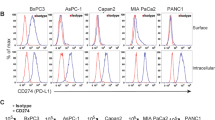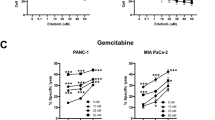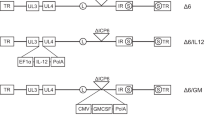Abstract
We examined whether novel cytokines, interleukin (IL)-21 and IL-23, that were expressed in tumors could produce antitumor effects in the inoculated mice. Human pancreatic cancer AsPC-1 cells were retrovirally transduced with murine IL-21 or IL-23 (p19-linked p40) gene (AsPC-1/IL-21, AsPC-1/IL-23) and were injected into nude or severe combined immunodeficiency (SCID) mice. Although the proliferation in vitro of the transduced cells remained the same as that of parent cells, growth of AsPC-1/IL-21 and AsPC-1/IL-23 tumors developed in nude mice was retarded compared with that of parent tumors. Treatment of nude mice with anti-asialo GM1 antibody temporally abrogated the growth retardation of AsPC-1/IL-21, but not AsPC-1/IL-23 tumors; however, the growth of AsPC-1/IL-21 tumors came to be retarded thereafter with the regeneration of natural killer (NK) cells. The growth of AsPC-1/IL-21 tumors developed in SCID mice was also retarded compared with parent tumors and the growth retardation was abrogated by treatment with anti-asialo GM1 antibody. The growth of AsPC-1/IL-23 tumors in SCID mice was not different from that of parent tumors. Cytotoxic activity and secretion of interferon-γ in response to AsPC-1 cells were induced in spleen cells of the mice bearing AsPC-1/IL-21 or AsPC-1/IL-23 tumors. When nude mice were injected with a mixed population of AsPC-1/IL-21 and AsPC-1/IL-23 cells, no synergistic effects were observed. These data collectively suggest that expression of IL-21 and IL-23 in tumors can produce NK cell-dependent and -independent antitumor effects in an αβ T cell-defective condition, respectively.
This is a preview of subscription content, access via your institution
Access options
Subscribe to this journal
Receive 12 print issues and online access
$259.00 per year
only $21.58 per issue
Buy this article
- Purchase on Springer Link
- Instant access to full article PDF
Prices may be subject to local taxes which are calculated during checkout





Similar content being viewed by others
References
Ridwelski K, Meyer F, Ebert M, et al. Prognostic parameters determining survival in pancreatic carcinoma and, in particular, after palliative treatment. Dig Dis. 2001;19:85–92.
Kimura M, Yoshida Y, Narita M, et al. Acquired immunity in nude mice induced by expression of the IL-2 or IL-4 gene in human pancreatic carcinoma cells and anti-tumor effect generated by in vivo gene transfer using retrovirus. Int J Cancer. 1999;82:549–555.
Yoshida Y, Tasaki K, Miyauchi M, et al. Impaired tumorigenicity of human pancreatic cancer cells retrovirally transduced with interleukin-12 or interleukin-15 gene. Cancer Gene Ther. 2000;7:324–331.
Abbas AK, Murphy KM, Sher A . Functional diversity of helper T lymphocytes. Nature 1996;383:787–793.
Parrish-Novok J, Dillon SR, Nelson A, et al. Interleukin 21 and its receptor are involved in NK cell expansion and regulation of lymphocyte function. Nature. 2000;408:57–63.
Oppmann B, Lesley R, Blom B, et al. Novel p19 protein engages IL-12p40 to form a cytokine, IL-23, with biological activities similar as well as distinct from IL-12. Immunity. 2000;13:715–725.
Voβhenrich CAJ, Di Santo JP . Cytokines: IL-21 joins the γc-dependent network? Curr Biol. 2001;11:R175–177.
Asao H, Okuyama C, Kumaki S, et al. The common γ-chain is an indispensable subunit of the IL-21 receptor complex. J Immunol. 2001;167:1–5.
Kasaian MT, Whitters MJ, Carter LL, et al. IL-21 limits NK cell responses and promotes antigen-specific T cell activation: a mediator of the transition from innate to adaptive immunity. Immunity. 2002;16:559–569.
Wurster AL, Rodgers VL, Satoskar AR, et al. Interleukin-21 is a T helper (Th) cells 2 cytokine that specifically inhibits the differentiation of naive Th cells into interferon γ-producing Th1 cells. J Exp Med. 2002;7:967–977.
Parham C, Chirica M, Timans J, et al. A receptor for the heterdimeric cytokine IL-23 is composed of IL-12Rβ1 and a novel cytokine receptor subunit, IL-23R. J Immunol. 2002;168:5699–5708.
Miller AD, Rosman GJ . Improved retroviral vectors for gene transfer and expression. BioTechniques. 1989;7:980–990.
Duke GM, Hoffman MA, Palmenberg AC . Sequence and structural elements that contribute to efficient encephalomyocarditis virus RNA translation. J Virol. 1992;66:1602–1609.
Kato K, Shimozato O, Hoshi K, et al. Local production of the p40 subunit of interleukin 12 suppresses T-helper 1-mediated immune responses and prevents allogeneic myoblast rejection. Proc Natl Acad Sci USA. 1996;93:9085–9089.
Ugai S, Shimozato O, Kawamura K, et al. Expression of the interleukin-21 gene in murine colon carcinoma cells generates systemic immunity in the inoculated hosts. Cancer Gene Ther. 2003;10:187–192.
Ling P, Gately MK, Gubler U, et al. Human IL-12 p40 homodimer binds to the IL-12 receptor but does not mediate biologic activity. J Immunol. 1995;154:116–127.
Gillessen S, Carvajal D, Ling P, et al. Mouse interleukin-12 (IL-12) p40 homodimer: a potent IL-12 antagonist. Eur J Immunol. 1995;25:200–206.
Seki S, Hashimoto W, Ogasawara K, et al. Antimetastatic effect of NK1+ T cells on experimental haematogenous tumour metastases in the liver and lungs of mice. Immunol. 1997;92:561–566.
Li Y, Newby SA, Johnston JV, et al. Protective immunity induced by B7/CD28-costimulated γδ T cells to the EL-4 lymphoma in allogenic athymic mice. J Immunol. 1995;155:5705–5710.
Cui J, Shin T, Kawano T, et al. Requirement of Vα14NKT cells in IL-12-mediated rejection of tumors. Science. 1997;278:1623–1626.
Schnurr M, Scholz C, Rothenfusser S, et al. Apoptotic pancreatic tumor cells are superior to cell lysates in promoting cross-priming of cytotoxic T cells and activated NK and γδ T cells. Cancer Res. 2002;62:2347–2352.
Jaffee EM, Hruban RH, Biedrzycki B, et al. Novel allogeneic granulocyte-macrophage colony-stimulating factor-secreting tumor vaccine for pancreatic cancer: a phase I trial of safety and immune activation. J Clin Oncol. 2001;19:145–156.
Acknowledgements
This work was supported by a grants-in-aid for scientific research from the Japan Society for the Promotion of Science (JSPS) and the Uehara Memorial Foundation. Ling Yu and Yan-Qing Wang were supported by the JSPS postdoctoral fellowship.
Author information
Authors and Affiliations
Corresponding author
Rights and permissions
About this article
Cite this article
Ugai, Si., Shimozato, O., Yu, L. et al. Transduction of the IL-21 and IL-23 genes in human pancreatic carcinoma cells produces natural killer cell-dependent and -independent antitumor effects. Cancer Gene Ther 10, 771–778 (2003). https://doi.org/10.1038/sj.cgt.7700630
Received:
Published:
Issue Date:
DOI: https://doi.org/10.1038/sj.cgt.7700630
Keywords
This article is cited by
-
Engineered murine IL-21-secreting leukemia cells induce granzyme B+ T cells and CD4+CD44+CD62L− effector memory cells while suppressing regulatory T cells, leading to long-term survival
Cancer Immunology, Immunotherapy (2023)
-
Interleukin-23 promotes the epithelial-mesenchymal transition of oesophageal carcinoma cells via the Wnt/β-catenin pathway
Scientific Reports (2015)
-
Bioengineered Colorectal Cancer Drugs: Orally Delivered Anti-Inflammatory Agents
Cell Biochemistry and Biophysics (2015)
-
IL-21 gene polymorphism is associated with the prognosis of breast cancer in Chinese populations
Breast Cancer Research and Treatment (2013)
-
The antitumor effects of adenoviral-mediated, intratumoral delivery of interleukin 23 require endogenous IL-12
Cancer Gene Therapy (2012)



